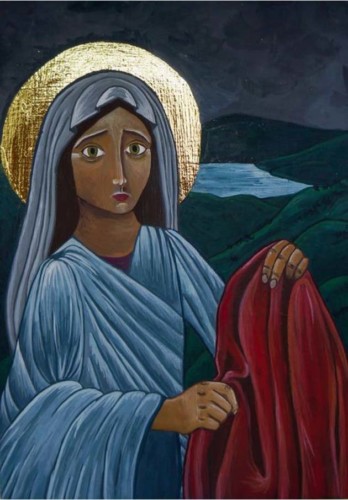Dr Emily Colgan (co-director of The Shiloh Project) interviews Hilary Willett

Orginal article: https://www.shilohproject.blog/writing-gender-justice-alternative-icons-of-women/ (reposted with permission)
Today’s post is an interview with Hilary Willett (she/her) who fights for gender justice by writing icons and reclaiming the lives of biblical women.
Tell us about yourself: who are you and what do you do?
My name is Hilary. I’m from Christchurch, New Zealand and currently living in Auckland. I’m studying to be an Anglican priest in the Diocese of Auckland.
What have you been doing and what are you working on?
I completed a Masters of Theology in 2018, looking at feminism and the Bible. This was a pivotal point in my faith journey. Before doing this thesis, I had believed that both Christians and biblical texts had always generally been fairly supportive of women in positions of leadership. My thesis disrupted this belief and I began to realise the extent to which the Christian church has suppressed or marginalised female leadership.
After finishing my thesis, I felt a call to leadership in the Anglican Church. In 2019, I was discerned to begin training for ordination. I’m now doing a second Masters in Theology, part-time, to aid my leadership formation. In 2020, I did a course on writing icons with Libby Brookbanks, and I discovered that I loved it. So, in my spare time, I’ve been writing icons of women and have recently started selling them and accepting commissions.

Phoebe, the Deacon
Which aspects of your work might be particularly interesting for supporters of the Shiloh Project?
Icons are considered sacred images and used in devotional ways. They are also considered to be a way of communicating orthodox theology, so instead of being “painted” they are written. Every part of an icon has theological significance: the colours used, the gestures of the subject, the gold-leaf/gilding, even the primer used to prepare the surface that will be written on. Everything in an icon has a symbolic meaning.
Traditionally, however, only men are allowed to be iconographers. This means that men have been the only ones allowed to communicate theology about the women and men represented in icons. I feel uncomfortable with this, particularly the idea that in iconography women are only being written by men. So, I started to write icons of women.
How does your work connect to activism?
I came away from my thesis on feminism and Christianity acutely aware of just how many men write the theological narrative. This dominance prevents women from writing themselves and leads to significant theological bias. In icons, this is particularly noticeable. Women are often represented as white (even when the majority of saints depicted are not Caucasian) and delicate (rarely do women look strong or have strong gestures). Women are often dressed in white or have white head-coverings to symbolise their purity. It seems that writers of icons are very keen to uphold purity as a prime virtue in women, which then reinforces this value in individuals who use icons for prayer.
Complex biblical women, such as Jael, Hagar, Delilah, or the woman who bled for twelve years, are very rarely recorded as icons. The few icons I found of the “bleeding woman” (Matt 9:20-22; Mark 5: 25-34; Luke 8:43-38), for example, depicted her as grovelling on her knees before Christ. This representation makes this woman one-dimensional. There is little visual reference in the icon to this woman’s faith or her courage in approaching Christ, despite the customary purity taboos forbidding a woman in her position from touching a rabbi. Her active defiance of the rules and her determination to be healed demonstrate strength and conviction, but these qualities are not represented visually in the bleeding woman’s icon. This is in stark contrast to say, Peter or Paul who, despite their failings, are regularly and reliably represented in icons. They are depicted as standing upright and righteous and are often depicted in a variety of colours. For instance, in a traditional Orthodox church, there is a section of the church called the “Deisis” (prayer/supplication). Peter and Paul are almost always a part of this prominent section of the church. They are written in full colour, venerated as complex and well-rounded individuals. Mary, the pure, is often the only female regularly included in this important section of the church.

Daughter of Faith (the woman who bled for 12 years)
I try to correct this bias by writing women differently. I spend some time researching alternative narratives, sometimes going very much against traditional theological presentations of certain women. In writing icons, I include ‘difficult’ characters and characters that are not in scripture or “sainted” by the Church. I write women with different skin tones, different personalities, and different body shapes. I tend to avoid using white clothes for women, unless it is absolutely necessary. One occasion where I did find this necessary, was with Phoebe, the deacon. Her white alb was a part of her official, ceremonial robes that deacons wore in the church. It is necessary for a deacon to wear an alb in their leadership role. In this case, Phoebe’s white clothes felt to be more about her leadership role in the church, which I wanted to highlight, rather than about her purity as a woman.
I also try to bring out the complexity of the women who have been venerated as pure and the humanity of the women who have been marginalised. As noted above, for instance, the ‘bleeding woman’ is usually depicted grovelling before Christ. When I re-wrote her, however, she is standing upright. Christ was not in the icon, as I wanted her to stand in her own right. I re-named her the “Daughter of Faith”.
I try to find something commendable in each of the women I write, with the view that women are worthy of respect, even if they are complex characters and don’t live up to patriarchal stereotypes. Women do not all need to be the purest of the pure, or the fem-est of the fem, to be admirable.
Finally, I enjoy writing women in contexts that are meaningful to the person who will use the icon. When I wrote Mary as an icon, I placed her in Taranaki (Aotearoa New Zealand) because that where the person who was receiving the icon was from. It felt important that the caring presence of Mary was placed in this own person’s context, making it meaningful and relevant to the person using the icon.

Mary, Mother of God
What has been the response to your icons?
To be honest, it has been overwhelmingly positive; it really has been lovely to see how many people are connecting with these images. Occasionally, some people haven’t understood exactly what an icon is and wonder why I don’t just paint landscapes, but it has been fun explaining this to them. One thing I often try to do is explain the symbolic features of any new icon I write. I think this has helped with the response, as it gives people the tools to “read” exactly what I am “writing”. It has meant that even people who have not been all that interested in icons in the past, are really keen and interested now. It has been a great experience!
Find more of Hilary’s icons at Lumen Icons: https://lumenicons.tarotpoetry.nz


